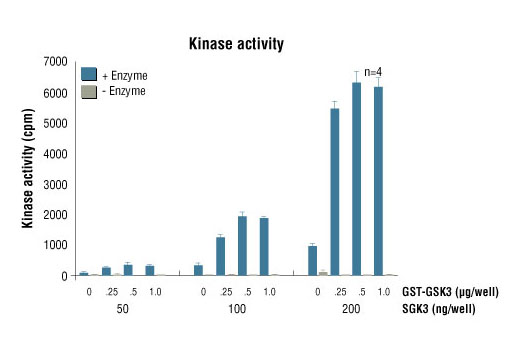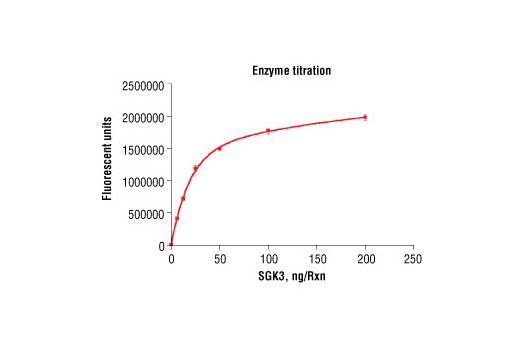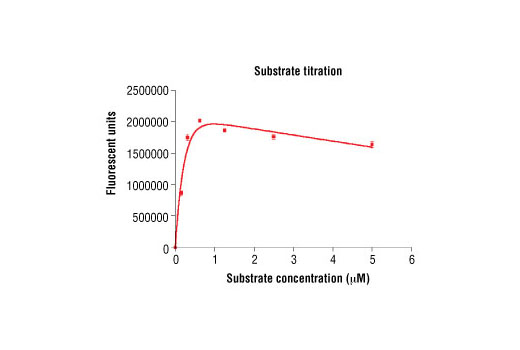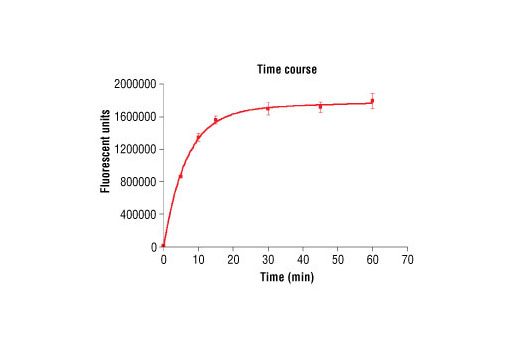#Q96BR1
23678
Product Information
Storage
5 mM DTT, 15 mM reduced glutathione and 20% glycerol. Store at -80°C.
Keep enzymes on ice during use.
Avoid repeated freeze-thaw cycles.
Source / Purification
The GST-Kinase fusion protein was produced using a baculovirus expression system with a construct expressing full-length human SGK3 (Met1-Leu496) (GenBank Accession No. NM_013257.3) with an amino-terminal GST tag. The protein was purified by one-step affinity chromatography using glutathione-agarose.
Product Description
| Molecular Formula | Peptide substrate, Biotin-PLK (Ser137): 1,945 Daltons. GST-SGK3 Kinase: 83 kDa. |
Background
Serum and glucocorticoid-inducible kinase (SGK) is a serine/threonine kinase closely related to Akt (1). SGK is rapidly induced in response to a variety of stimuli, including serum, glucocorticoid, follicle stimulating hormone, osmotic shock, and mineralocorticoids. SGK activation can be accomplished via HGF PI3K-dependent pathways and by integrin-mediated PI3K-independent pathways (2,3). Induction and activation of SGK has been implicated in activating the modulation of anti-apoptotic and cell cycle regulation (4-6). SGK also plays an important role in activating certain potassium, sodium, and chloride channels, suggesting its involvement in the regulation of processes such as cell survival, neuronal excitability, and renal sodium excretion (2). SGK is negatively regulated by ubiquitination and proteasome degradation (7).
- Webster, M.K. et al. (1993) Mol Cell Biol 13, 2031-40.
- Kobayashi, T. and Cohen, P. (1999) Biochem J 339 ( Pt 2), 319-28.
- Park, J. et al. (1999) EMBO J 18, 3024-33.
- Brunet, A. et al. (2001) Mol Cell Biol 21, 952-65.
- Mikosz, C.A. et al. (2001) J Biol Chem 276, 16649-54.
- Hayashi, M. et al. (2001) J Biol Chem 276, 8631-4.
- Brickley, D.R. et al. (2002) J Biol Chem 277, 43064-70.
Species Reactivity
Species reactivity is determined by testing in at least one approved application (e.g., western blot).
Cross-Reactivity Key
H: human M: mouse R: rat Hm: hamster Mk: monkey Vir: virus Mi: mink C: chicken Dm: D. melanogaster X: Xenopus Z: zebrafish B: bovine Dg: dog Pg: pig Sc: S. cerevisiae Ce: C. elegans Hr: horse GP: Guinea Pig Rab: rabbit All: all species expected
Trademarks and Patents
Limited Uses
Except as otherwise expressly agreed in a writing signed by a legally authorized representative of CST, the following terms apply to Products provided by CST, its affiliates or its distributors. Any Customer's terms and conditions that are in addition to, or different from, those contained herein, unless separately accepted in writing by a legally authorized representative of CST, are rejected and are of no force or effect.
Products are labeled with For Research Use Only or a similar labeling statement and have not been approved, cleared, or licensed by the FDA or other regulatory foreign or domestic entity, for any purpose. Customer shall not use any Product for any diagnostic or therapeutic purpose, or otherwise in any manner that conflicts with its labeling statement. Products sold or licensed by CST are provided for Customer as the end-user and solely for research and development uses. Any use of Product for diagnostic, prophylactic or therapeutic purposes, or any purchase of Product for resale (alone or as a component) or other commercial purpose, requires a separate license from CST. Customer shall (a) not sell, license, loan, donate or otherwise transfer or make available any Product to any third party, whether alone or in combination with other materials, or use the Products to manufacture any commercial products, (b) not copy, modify, reverse engineer, decompile, disassemble or otherwise attempt to discover the underlying structure or technology of the Products, or use the Products for the purpose of developing any products or services that would compete with CST products or services, (c) not alter or remove from the Products any trademarks, trade names, logos, patent or copyright notices or markings, (d) use the Products solely in accordance with CST Product Terms of Sale and any applicable documentation, and (e) comply with any license, terms of service or similar agreement with respect to any third party products or services used by Customer in connection with the Products.




